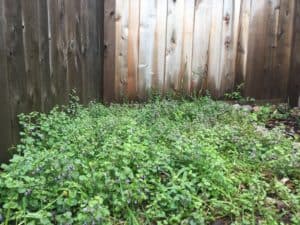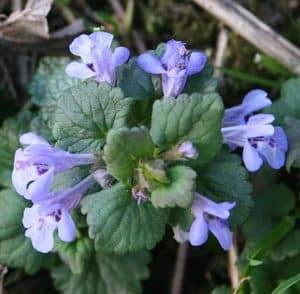
In the twin cities, spring brings complaints- about creeping charlie taking over lawns, strangling garden plants, and being generally relentless. But is the creeping charlie flower a good source of food for bees? In researching creeping charlie, we uncovered a fascinating story about this invasive plant’s strategy to draw insect pollinators. Creeping charlie draws a lot of insect visitors, including bees. Sweat bees, bumble bees, and honey bees are among its most popular insect visitors. Creeping charlie flowers have an interesting strategy for rewarding pollinators. This strategy is called “lucky hit.” They produce nectar with an average volume of 0.3 mL per flower, but the amount of nectar varies greatly, with a range of 0.06-2.4 mL of nectar available per flower. Out of 805 flowers, Southwick found that 8% (64/805 flowers) had a large volume of nectar, and the rest of the flowers provided almost none. The availability of nectar also varies throughout the day. As the morning fades into afternoon, “lucky hits” become less frequent, as creeping charlie flowers do not replenish their nectar throughout the day. Most flowers produce their nectar at night or in the early morning, so it is believed that all the “lucky hits” available in the afternoon are ones that were missed by bees and other nectar collectors earlier in the day. This raised an interesting question- is it energetically efficient for a bee to visit creeping charlie? Southwick found that foraging on creeping charlie likely does provide a net gain of energy. Each lucky hit provides enough calories for 5.9 minutes of foraging, and with the density of flowers produced by creeping charlie plants, bees can probably visit enough flowers per minute to make an energetic profit. The plants are able to produce less nectar over time (even though they sometimes they produce a lot), and so conserve energy. As long as they produce ‘lucky hits’ enough to be an energetically profitable food source, bees will continue to visit. Additionally, the lucky hit strategy may increase pollination success for the flower. Assuming bees cannot tell whether a flower is a lucky hit until they are actively visiting, the bees that visit must be persistent to hit the jackpot. Since they don’t spend a lot of time on flowers without nectar, but still transfer pollen from flower to flower during their search, they may pollinate more flowers per minute than they would if each flower had an average amount of nectar.

While Creeping charlie could be a good nectar source for bees, we are not recommending that you let it take over your lawn. Bees need more than nectar- they also need pollen (the main protein source for bees). Pollen is not readily available from creeping charlie. Bees also need a variety of food sources, and the best lawns have many kinds of flowers, hopefully with a range of bloom times. Creeping charlie is invasive, and can prevent you from growing other types of flowers in your lawn. If you are looking to promote pollinator health in your lawn or garden, we recommend planting a diversity of flowers that produce high quality nectar and pollen consistently over the growing season. James Wolfin, a masters student in the Spivak lab studying bee lawns, has provided tips, below, for excluding creeping charlie when establishing a lawn and eradicating it if it has already established. That being said, if your lawn/garden is already overrun with creeping charlie, and you have not had a chance to eradicate it yet, take pleasure in seeing the bees buzzing around it, and look out for when they spend extra time on one bloom. They are likely hitting the jackpot!
When does creeping charlie grow? (Establishing a lawn without creeping charlie)
Creeping charlie prospers most in shaded areas that have poor ground cover, but can become present throughout the entirety of a lawn, especially in situations where there is an abundance of bare ground, or where turf coverage density is low. Once established, creeping charlie has the ability to suppress the growth of surrounding plants, due to a characteristic called “allelopathy”. This means that it releases chemicals into the ground that suppress the growth of surrounding plants. One study (Rice, 1986) found that flowers growing alongside creeping charlie experienced decreased seed germination and faster rates of root and shoot growth.
The first thing to consider when establishing a home lawn should be species selection. Kentucky bluegrass is typically the preferred grass in the Northern US, due to its high quality and winter hardiness, but it struggles in shady areas, leading to poor turfgrass coverage. The combination of bare ground soil and shade serve as an ideal habitat for creeping charlie to establish and potentially spread. To avoid this situation, it is important that homeowners seed grasses that are well adapted to shady areas. Both tall fescue (Festuca anrundinacea) and fine fescue (Festuca spp.) are cool-climate turfgrass species that do grow well in shady areas. You can mix fescues with Kentucky bluegrass to ensure that you have a strong density of grass, even in the shady areas of your yard.
Eradicating creeping charlie
If creeping charlie has already established in your lawn, there are 2 easy ways to eradicate without using chemicals. You can use a sod-cutter, a machine that typically removes sod for transplant into a new lawn, but can be used to quickly remove strips of weeds, like creeping charlie, from a lawn. Removing strips of creeping charlie will create an area of bare soil within the lawn. This is the ideal habitat for creeping charlie to establish, so it is important to completely eradicate it promptly seed with high quality grass to ensure dense, uniform germination throughout the area.
You can also eradicate creeping charlie through solarization. To solarize, you place a clear, plastic sheet over the soil when it is hot and sunny. The clear plastic sheet captures heat and sunlight, raising soil temperatures to the point where grasses and weeds can no longer survive. Solarization is best fit for sunny, flat sites that are below ½ of an acre in size. In cooler climates the process of solarization takes the better part of a growing season, typically 5-6 months, or up to a full year in some instances. The plastic should be removed in the late fall when soil temperatures are 35-55°F so that new grass can be installed via dormant seeding. These temperatures are ideal because the soil is too cold for germination to occur, but the ground is not yet frozen. This ensures that the target species will be the first to germinate. In the spring, the new turfgrass area should be dense, uniform, and free of weed pressure.
Works cited:
Dickinson, R. and Royer, F. Weeds of North America, University of Chicago Press, Chicago, IL. 2014
Foord, K. 2016. The value of lawn weeds for pollinators: Not all weeds are created equal. Yard and Garden News, University of Minnesota Extension. http://blog-yard-garden-news.extension.umn.edu/2016/05/the-value-of-lawn-weeds-for-pollinators.html Accessed 06/19/17
Hultén, E. 1971. The Circumpolar Plants. II. Dicotyledons. Almquist & Wiksell, Sweden.
Hutchings, M.J., Price, E.A.C. 1999. Glechoma hederacea L. (Nepeta glechoma Benth., N. hederacea (L.) Trev.)
Rice, E.L. 1986. Allelopathic growth stimulation. The Science of Allelopathy (eds A.R. Putnam & C.S. Tang), pp. 34-40. Wiley, Chichester, UK.
Southwick, E. E. “Lucky Hit” nectar rewards and energetics of plant and pollinators.” Comparative Physiology and Ecology 7.2 (1982): 51-55.
Southwick, Edward E., Gerald M. Loper, and Steven E. Sadwick. “Nectar production, composition, energetics and pollinator attractiveness in spring flowers of western New York.” American Journal of Botany (1981): 994-1002.